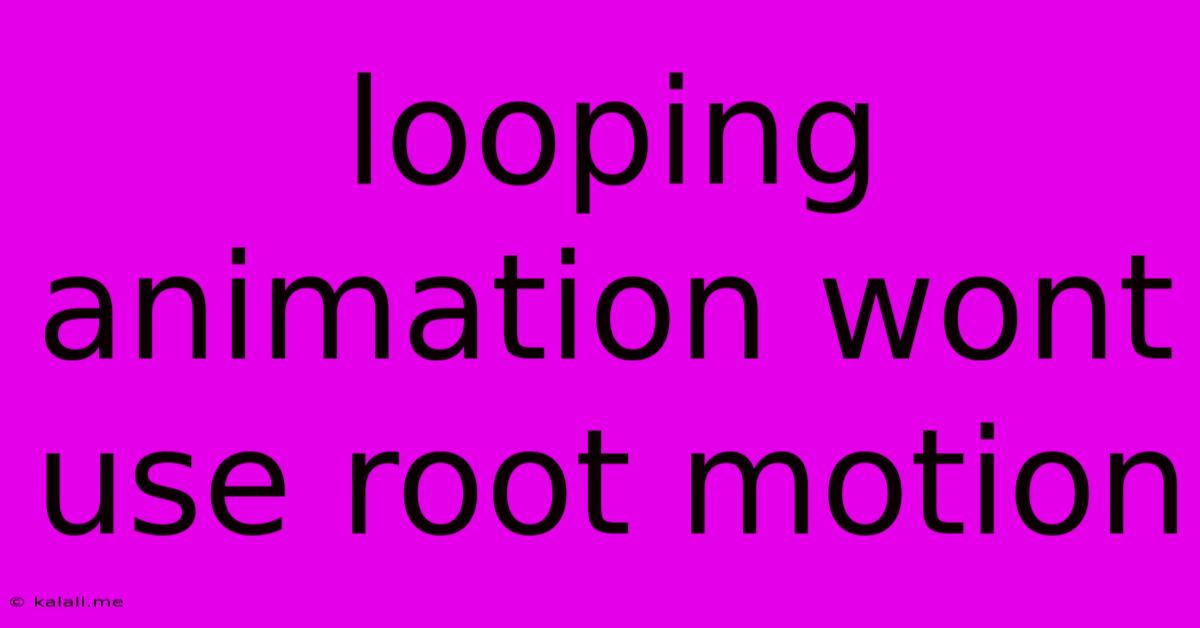Looping Animation Wont Use Root Motion
Kalali
Jun 11, 2025 · 3 min read

Table of Contents
Looping Animation Without Root Motion: A Guide for Animators
This article tackles a common challenge in animation: creating seamless looping animations that avoid the jarring effects of root motion. Root motion, while useful for many animations, can often disrupt the loop, creating noticeable pops or shifts in the character's position over repeated cycles. This guide will explore techniques to achieve smooth, believable looping animations without relying on root motion, enhancing the quality of your animations significantly.
What is Root Motion and Why Avoid It in Loops?
Root motion refers to the movement of an animation's root bone, often the pelvis or hip. While it simplifies character movement and provides accurate positioning for gameplay, it introduces problems when creating seamless loops. Since root motion directly dictates the character's position in the world, any slight variation in the animation's ending pose compared to its starting pose will be amplified across multiple loops, causing visible pops and inconsistencies. This is particularly problematic in animations meant to play indefinitely, such as idle animations or walking cycles.
Techniques for Looping Animations Without Root Motion:
Several strategies can be used to create smooth looping animations without root motion:
1. Careful Animation and Pose Matching:
This is the fundamental approach. Pay meticulous attention to the ending and starting poses of your animation. Ensure that the character's position, rotation, and bone poses are identical at the beginning and end. This requires careful planning and precision during the animation process. This process may involve:
- Keyframing: Carefully adjusting keyframes at the beginning and end to perfectly match.
- Pose Matching Tools: Utilizing software features specifically designed for pose matching, comparing and adjusting poses for smoother transitions.
- Iteration and Refinement: Expect multiple iterations; even minor discrepancies will be noticeable over repeated cycles.
2. Using Offset Animation:
Instead of relying on root motion, you can offset the character's movement. This involves animating only the character's limbs and upper body, leaving the root bone stationary. Any movement is achieved through subtle shifts in limb positions and rotations. This approach is ideal for animations where the character remains relatively stationary, such as idle animations or slight body movements.
3. Inverse Kinematics (IK) for Subtle Adjustments:
IK can be invaluable in fine-tuning your loop. By using IK to adjust limb positions, you can achieve more organic and realistic movement that maintains smooth loops. This is especially helpful in addressing minor pose discrepancies that may otherwise be difficult to resolve manually.
4. Utilizing Animation Layers and Blending:
Breaking down your animation into layers (e.g., body, arms, legs) can simplify the loop process. You can then blend these layers, focusing on aligning and matching poses across the layers to ensure seamless transitions. This technique is particularly beneficial for complex animations where different body parts have varying movements.
5. Pre-processing and Editing Tools:**
Some animation software packages offer tools for automatically detecting and fixing loop issues. These tools often analyze your animation and suggest adjustments to improve the loop's smoothness. While not a replacement for careful animation, these tools can be valuable assets in the process.
Choosing the Right Approach:
The best technique depends on your specific animation and desired outcome. For simple animations, careful pose matching may suffice. Complex animations might benefit from a combination of methods, such as IK and animation layers. Experimenting with different techniques is crucial to find the optimal workflow for your project.
By employing these techniques, you can create high-quality looping animations that are both visually appealing and technically sound, free from the limitations and artifacts often associated with relying solely on root motion. Remember, patience and attention to detail are key in achieving seamless animation loops.
Latest Posts
Latest Posts
-
Toe In Toe Out Tire Wear
Jun 12, 2025
-
Difference Between Simple And Compound Microscope
Jun 12, 2025
-
How Would You Remove Moisture From Refrigerant In A System
Jun 12, 2025
-
What Is Mmxx In Roman Numerals
Jun 12, 2025
-
Laplace Transform Calculator Step By Step
Jun 12, 2025
Related Post
Thank you for visiting our website which covers about Looping Animation Wont Use Root Motion . We hope the information provided has been useful to you. Feel free to contact us if you have any questions or need further assistance. See you next time and don't miss to bookmark.